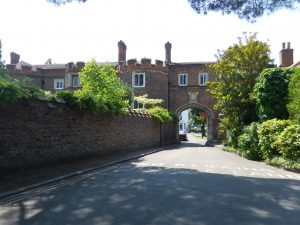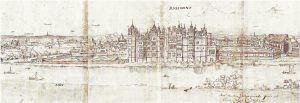


Images: gatehouse from Richmond green; detail of royal coat of arms on gatehouse (photos: C.A. Stanford), and 1562 drawing by Antony Wyngaerde (Public Domain, https://commons.wikimedia.org/w/index.php?curid=14652626).
Acquired: 1509 (by inheritance)
The royal palace at Sheen, on the bank of the Thames, was restored by Henry VII after a catastrophic fire in 1497. Renamed in tribute to the first Tudor king’s title as earl of Richmond, it became the focus of intense rebuilding, although none of the accounts has survived.
The royal apartments were located in a self-contained block along the riverfront, with apartments for officials on the ground floor, and the king’s and queen’s apartments on the upper two floors. This “stacked” arrangement of lodgings was probably derived from Continental models and was a commonly adopted solution in several of the palaces Henry VIII inherited from his father or built early in his reign (such as Bridewell), though later he rejected that pattern in favor of separate wings. The palace center focused on the key sites of chapel and hall, with the great court beyond, fronting on Richmond Green to the north. A gallery connected these sites to an adjacent church for a friary of Observant Franciscans, founded by Henry’s father, but suppressed in 1534 by Henry himself. Though he may have added some features, such as the “tennis play,” Henry VIII did not make much use of Richmond, first bestowing it on Cardinal Wolsey in exchange for Hampton Court ca. 1527, then after that minister’s fall, bestowing it on his fourth wife, Anne of Cleves, in 1540.
Richmond continued as a royal palace until the Civil War, but today only fragments remain.
*Click here to see the women vendors that worked at this site.